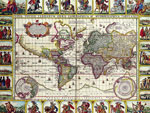Your children are fortunate that you are anxious and willing to share the joys and wonders of history with them at an early age! The following suggestions (and materials) should assist in launching their voyage through time in a manner that is fun, informative, and thought-provoking.
Activities
A great way to start is with a children's globe or map. The children can find their location and the "new" locations as you introduce them to different places and times.
You and your children can construct your own timeline as you study different periods in history.
To introduce the concept of “time” try the book titled A Street Through Time. This work traces the changes in one street—across 12,000 years. You and your children can construct your own timeline as you study different periods in history. Have them make a "time capsule" of their favorite objects. As you progress through each era, they can construct new "time capsules." Drawings or pictures of objects can be placed in a shoebox "time capsule." These can be "visited" and additional objects can be added to the time capsule during these "visits."
Why not create a "Wonder Wall?" Your children can post flags or question marks about a time period or subject that intrigues them. They can post names/drawings of people that they've come across onto a timeline that you've created—different colors for fiction and nonfictional characters.
Art projects are a terrific way to engage children. They can:
- create "time hats" to wear each time they travel to another time period.
- make "passports" that are stamped upon arrival at each destination.
- use a large box to create their own "Wayback Machine."
- use clay to make a pyramid, cotton gauze to make mummies when studying ancient Egypt.
- dress a doll in togas, saris, or armor; they can make "togas" for themselves as you read about ancient Rome. Some of the Reader's Theatre books can assist with this.
- create and eat foods from other times.
You can add to the magic by dressing up as a typical mother from one of these time periods and reading them relevant fiction.
You can also have your children study biographies of historical figures and then create a fictional biography of a child from that period. This is a great way to teach children to determine the difference between fiction and nonfiction. You can add to the magic by dressing up as a typical mother from one of these time periods and reading them relevant fiction.
Mythology is a fascinating subject for children and very useful in teaching about different times and places. Norse, Greek, Roman, Chinese, African—tales from around the world will delight children as well as pique their curiosity about different times and places.
Series books by Dorling Kindersley (DK), including Eyewitness as well as The Magic Treehouse series, and Magic Wagon books are rich with information and text.
Let me also put in a plug for your local library. The librarians there will know what relevant works are in their collections and be happy to share them with you and your children.
Happy travels!
